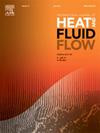Study on noise reduction performance of two-dimensional pillar shapes and porous medium
IF 2.6
3区 工程技术
Q2 ENGINEERING, MECHANICAL
International Journal of Heat and Fluid Flow
Pub Date : 2025-04-23
DOI:10.1016/j.ijheatfluidflow.2025.109855
引用次数: 0
Abstract
To study the effects of two-dimensional (2D) pillar shapes and the parameters of porous materials on flow field characteristics and aerodynamic noise, this study employs the Improved Delayed Detached Eddy Simulation (IDDES) method combined with the Ffowcs Williams-Hawkins (FW-H) equation to numerically simulate the flow field and aerodynamic noise of the pillars with variable cross-sections (cylindrical pillar, elliptical pillar, rounded square pillar and square pillar) and pillars covering with porous medium. The parameters of the porous medium under investigation include: porosity (), particle diameter (dp) and medium layer thickness (h). Proper Orthogonal Decomposition (POD) was utilized to perform reduced-order analysis of unsteady flow in the wake region, revealing the physical significance of POD modes of different pillars in wake evolution. The results indicate that the elliptical pillar exhibits the best performance in noise reduction, with its design allowing for a maximum reduction of 7 dBA in the far-field overall sound pressure level, among the four types of pillars with variable cross-sections. And the three types of porous medium parameters significantly affect the noise reduction performance of the pillar. Among them, the pillar with parameter combination of dp = 500 μm, =0.97, and h = 0.25 D exhibit superior noise reduction effects, with a maximum reduction of 10.2 dBA in the far-field overall sound pressure level. Porous medium layer with reasonable parameters can significantly delay boundary layer separation, extend the stable region of the shear layer, and attenuate velocity and vorticity magnitudes in the wake region, thus suppressing turbulence fluctuations and aerodynamic noise.
二维柱形和多孔介质的降噪性能研究
为了研究二维(2D)支柱形状和多孔材料参数对流场特性和气动噪声的影响,本研究采用改进的延迟分离涡模拟(IDDES)方法,结合 Ffowcs Williams-Hawkins (FW-H)方程,对不同截面(圆柱形支柱、椭圆形支柱、圆角方形支柱和方形支柱)的支柱和覆盖多孔介质的支柱的流场和气动噪声进行了数值模拟。所研究的多孔介质参数包括:孔隙率 (j)、颗粒直径 (dp) 和介质层厚度 (h)。利用适当正交分解(POD)对尾流区域的非稳态流动进行了降阶分析,揭示了不同支柱的 POD 模式在尾流演化过程中的物理意义。结果表明,在四种横截面可变的支柱中,椭圆支柱的降噪性能最好,其设计可使远场总声压级最大降低 7 dBA。而三种多孔介质参数对支柱的降噪性能影响很大。其中,参数组合为 dp = 500 μm、j=0.97、h = 0.25 D 的支柱降噪效果更优,远场总声压级最大降低了 10.2 dBA。参数合理的多孔介质层可以显著延迟边界层分离,延长剪切层的稳定区域,衰减尾流区的速度和涡度大小,从而抑制湍流波动和气动噪声。
本文章由计算机程序翻译,如有差异,请以英文原文为准。
求助全文
约1分钟内获得全文
求助全文
来源期刊

International Journal of Heat and Fluid Flow
工程技术-工程:机械
CiteScore
5.00
自引率
7.70%
发文量
131
审稿时长
33 days
期刊介绍:
The International Journal of Heat and Fluid Flow welcomes high-quality original contributions on experimental, computational, and physical aspects of convective heat transfer and fluid dynamics relevant to engineering or the environment, including multiphase and microscale flows.
Papers reporting the application of these disciplines to design and development, with emphasis on new technological fields, are also welcomed. Some of these new fields include microscale electronic and mechanical systems; medical and biological systems; and thermal and flow control in both the internal and external environment.
 求助内容:
求助内容: 应助结果提醒方式:
应助结果提醒方式:


